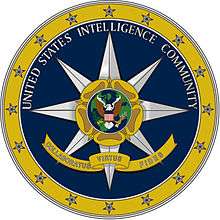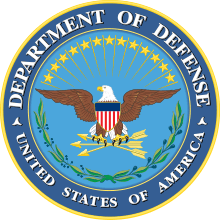National Reconnaissance Office
 | |
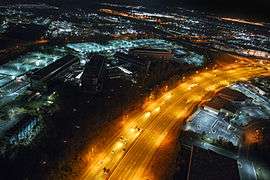 NRO headquarters at night | |
| Agency overview | |
|---|---|
| Formed |
Established: September 6, 1961 Declassified: September 18, 1992 |
| Jurisdiction | United States |
| Headquarters | Chantilly, Virginia, U.S. |
| Motto |
Supra Et Ultra (Above And Beyond) |
| Annual budget | Classified |
| Agency executives |
|
| Parent agency | Department of Defense |
| Website |
www |
| Part of a series on |
| Global surveillance |
|---|
 |
| Disclosures |
| Systems |
| Agencies |
| People |
| Places |
| Laws |
| Proposed changes |
| Concepts |
| Related topics |
|
The National Reconnaissance Office (NRO) is a member of the United States Intelligence Community and an agency of the United States Department of Defense. NRO is considered, along with the Central Intelligence Agency (CIA), National Security Agency (NSA), Defense Intelligence Agency (DIA), and National Geospatial-Intelligence Agency (NGA), to be one of the "big five" U.S. intelligence agencies.[2] The NRO is headquartered in unincorporated Fairfax County, Virginia,[3] 2 miles (3.2 km) south of Washington Dulles International Airport.
It designs, builds, and operates the reconnaissance satellites of the U.S. federal government, and provides satellite intelligence to several government agencies, particularly signals intelligence (SIGINT) to the NSA, imagery intelligence (IMINT) to the NGA, and measurement and signature intelligence (MASINT) to the DIA.[4]
The Director of the NRO reports to both the Director of National Intelligence and the Secretary of Defense[5] and serves in an additional capacity as Assistant Secretary of the Air Force (Intelligence Space Technology). The NRO's federal workforce consists primarily of Air Force, CIA, NGA, NSA, and Navy personnel.[6] A 1996 bipartisan commission report described the NRO as having by far the largest budget of any intelligence agency, and "virtually no federal workforce", accomplishing most of its work through "tens of thousands" of defense contractor personnel.[7]
Mission
The National Reconnaissance Office (NRO) develops and operates space reconnaissance systems and conducts intelligence-related activities for U.S. national security.[8]
It also coordinates collection and analysis of information from airplane and satellite reconnaissance by the military services and the Central Intelligence Agency.[9] It is funded through the National Reconnaissance Program, which is part of the National Intelligence Program (formerly known as the National Foreign Intelligence Program). The agency is part of the Department of Defense.
The NRO works closely with its intelligence and space partners, which include the National Security Agency (NSA), the National Geospatial-Intelligence Agency (NGA), the Central Intelligence Agency (CIA), the Defense Intelligence Agency (DIA), the United States Strategic Command, Naval Research Laboratory and other agencies and organizations.
It has been proposed that the NRO share imagery of the United States itself with the National Applications Office for domestic law enforcement.[10] The NRO operates ground stations around the world that collect and distribute intelligence gathered from reconnaissance satellites.
According to Asia Times Online, one important mission of NRO satellites is the tracking of non-US submarines on patrol or on training missions in the world's oceans and seas.[11]
History



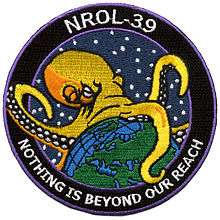
The NRO was established on August 25, 1960, after management problems and insufficient progress with the USAF satellite reconnaissance program (see SAMOS and MIDAS).[13]:23[14] The formation was based on a 25 August 1960 recommendation to President Dwight D. Eisenhower during a special National Security Council meeting, and the agency was to coordinate the USAF and CIA's (and later the navy and NSA's) reconnaissance activities.[13]:46
The NRO's first photo reconnaissance satellite program was the Corona program,[15]:25–28 the existence of which was declassified February 24, 1995, and which existed from August 1960 to May 1972 (although the first test flight occurred on February 28, 1959). The Corona system used (sometimes multiple) film capsules dropped by satellites, which were recovered mid-air by military craft. The first successful recovery from space (Discoverer XIII) occurred on August 12, 1960, and the first image from space was seen six days later. The first imaging resolution was 8 meters, which was improved to 2 meters. Individual images covered, on average, an area of about 10 by 120 miles (16 by 193 km). The last Corona mission (the 145th), was launched May 25, 1972, and this mission's last images were taken May 31, 1972. From May 1962 to August 1964, the NRO conducted 12 mapping missions as part of the "Argon" system. Only seven were successful.[15]:25–28 In 1963, the NRO conducted a mapping mission using higher resolution imagery, as part of the "Lanyard" program. The Lanyard program flew one successful mission. NRO missions since 1972 are classified, and portions of many earlier programs remain unavailable to the public.
Existence
The first press reports on NRO started in 1971.[16] The first official acknowledgement of NRO was a Senate committee report in October 1973, which inadvertently exposed the existence of the NRO.[17] In 1985, a New York Times article revealed details on the operations of the NRO.[18]
The existence of the NRO was declassified on September 18, 1992, by the Deputy Secretary of Defense, as recommended by the Director of Central Intelligence.[19]
Funding controversy
A Washington Post article in September 1995 reported that the NRO had quietly hoarded between $1 billion and $1.7 billion in unspent funds without informing the Central Intelligence Agency, the Pentagon, or Congress. The CIA was in the midst of an inquiry into the NRO's funding because of complaints that the agency had spent $300 million of hoarded funds from its classified budget to build a new headquarters building in Chantilly, Virginia, a year earlier.
In total, NRO had accumulated US$3.8 billion (inflation adjusted US$ 6.1 billion in 2018) in forward funding. As a consequence, NRO's three distinct accounting systems were merged.[20]
The presence of the classified new headquarters was revealed by the Federation of American Scientists who obtained unclassified copies of the blueprints filed with the building permit application. After 9/11 those blueprints were apparently classified. The reports of an NRO slush fund were true. According to former CIA general counsel Jeffrey Smith, who led the investigation: "Our inquiry revealed that the NRO had for years accumulated very substantial amounts as a 'rainy day fund.'"[21]
Future Imagery Architecture
In 1999 the NRO embarked on a $25 billion[22] project with Boeing entitled Future Imagery Architecture to create a new generation of imaging satellites. In 2002 the project was far behind schedule and would most likely cost $2 billion to $3 billion more than planned, according to NRO records. The government pressed forward with efforts to complete the project, but after two more years, several more review panels and billions more in expenditures, the project was killed in what the Times report calls "perhaps the most spectacular and expensive failure in the 50-year history of American spy satellite projects."[23]
9/11
In what the government described as a bizarre coincidence, the NRO was planning an exercise on September 11, 2001, involving an accidental aircraft crash into one of its buildings.[24] They planned to simulate the crash by closing off an area of doors and stairwells in the building to make employees find alternate routes out. This has been cited by 9/11 conspiracy theorists as proof of their beliefs.[25] During the attacks most of the employees at NRO headquarters were evacuated, save for essential personnel.[24] In charge of the exercise was CIA man John Fulton, head of the NRO's Strategic War Gaming Division.[24] [See below.]
Mid 2000s to present
In January 2008, the government announced that a reconnaissance satellite operated by the NRO would make an unplanned and uncontrolled re-entry into the Earth's atmosphere in the next several months. Satellite watching hobbyists said that it was likely the USA-193, built by Lockheed Martin Corporation, which failed shortly after achieving orbit in December 2006.[26] On February 14, 2008, the Pentagon announced that rather than allowing the satellite to make an uncontrolled re-entry, it would instead be shot down by a missile fired from a Navy cruiser.[27] The intercept took place on February 21, 2008.[28]
In July 2008, the NRO declassified the existence of its Synthetic Aperture Radar satellites, citing difficulty in discussing the creation of the Space-Based Radar with the United States Air Force and other entities.[29]
In August 2009, FOIA archives were queried for a copy of the NRO video, "Satellite Reconnaissance: Secret Eyes in Space." [30] The 7 minute video chronicles the early days of the NRO and many of its early programs.
At the National Space Symposium in April 2010 NRO director, General Bruce Carlson, USAF (Ret.) announced that till the end of 2011 NRO is embarking on "the most aggressive launch schedule that this organization has undertaken in the last twenty-five years. There are a number of very large and very critical reconnaissance satellites that will go into orbit in the next year to a year and a half."[31]
In 2012, a McClatchy investigation found that the NRO was possibly breaching ethical and legal boundaries by encouraging its polygraph examiners to extract personal and private information from DoD personnel during polygraph tests that were purported to be limited to counterintelligence issues.[32] Allegations of abusive polygraph practices were brought forward by former NRO polygraph examiners.[33] In 2014, an inspector general's report concluded that NRO failed to report felony admissions of child sexual abuse to law enforcement authorities. NRO obtained these criminal admissions during polygraph testing but never forwarded the information to police. NRO's failure to act in the public interest by reporting child sexual predators was first made public in 2012 by former NRO polygraph examiners.[34]
Organization

The NRO is part of the Department of Defense. The Director of the NRO is appointed by the Secretary of Defense with the consent of the Director of National Intelligence, without confirmation from Congress. Traditionally, the position was given to either the Under Secretary of the Air Force or the Assistant Secretary of the Air Force for Space, but with the appointment of Donald Kerr as Director of the NRO in July 2005 the position is now independent. The Agency is organized as follows:[35]
Principal Deputy Director of the NRO (PDDNRO)
- Reports to and coordinates with the DNRO on all NRO activities and handles the daily management of the NRO with decision responsibility as delegated by the DNRO; and,
- In the absence of the Director, acts on behalf of the DNRO.
Deputy Director of the NRO (DDNRO)
- Senior USAF general officer. Represents those civilian/uniformed USAF personnel assigned to the NRO;
- Assists both the DNRO and PDDNRO in the daily direction of the NRO; and,
- Coordinates activities between the USAF and the NRO.
The Corporate Staff
- Encompasses all those support functions such as legal, diversity, human resources, security/counter-intelligence, procurement, public affairs, etc. necessary for the day-to-day operation of the NRO and in support of the DNRO, PDNRO, and DDNRO.
Office of Space Launch (OSL)
- Responsible for all aspects of a satellite launch including launch vehicle hardware, launch services integration, mission assurance, operations, transportation, and mission safety; and,
- OSL is NRO's launch representative with industry, the USAF, and NASA.
Advanced Systems and Technology Directorate (AS&T)
- Invents and delivers advanced technologies;
- Develops new sources and methods; and,
- Enables multi-intelligence solutions.
Deputy Director for Business Plans and Operations (BPO)
- Responsible for all financial and, budgetary aspects of NRO programs and operations; and,
- Coordinates all legislative, international, and public affairs communications.
Communications Systems Acquisition Directorate (COMM)
- Supports the NRO by providing communications services through physical and virtual connectivity; and,
- Enables the sharing of mission critical information with mission partners and customers.
Ground Enterprise Directorate (GED)
- Provides an integrated ground system that sends timely information to users worldwide.
Imagery Intelligence Systems Acquisition Directorate (IMINT)
- Responsible for acquiring NRO's technologically advanced imagery collection systems, which provides geospatial intelligence data to the Intelligence Community and the military.
Management Services and Operations (MS&O)
- Provides services such as facilities support, transportation and warehousing, logistics, and other business support, which the NRO needs to operate on a daily basis.
Mission Operations Directorate (MOD)
- Operates, maintains and reports the status of NRO satellites and their associated ground systems;
- Manages the 24-hour NRO Operations Center (NROC) which, working with U.S Strategic Command, provides defensive space control and space protection, monitors satellite flight safety, and provides space situational awareness.
Mission Support Directorate (MSD)
- Engages with users of NRO systems to understand their operational and intelligence problems and provide solutions in collaboration with NRO's mission partners.
Signals Intelligence Systems Acquisition Directorate (SIGINT)
- This directorate builds and deploys NRO's signals intelligence satellite systems that collect communication, electronic, and foreign instrumentation signals intelligence.
Systems Engineering Directorate (SED)
- Provides beginning-to-end systems engineering for all of NRO's systems.
Personnel
In 2007, the NRO described itself as "a hybrid organization consisting of some 3,000 personnel and jointly staffed by members of the armed services, the Central Intelligence Agency and DOD civilian personnel."[36] Between 2010 and 2012, the workforce is expected to increase by 100.[37] The majority of workers for the NRO are private corporate contractors, with $7 billion of the agency's $8 billion budget going to private corporations.[15]:178
Budget

The NRO derives its funding both from the US intelligence budget and the military budget. In 1971, the annual budget was estimated to be around $1 billion (inflation adjusted $ 6.0 billion in 2018).[16] A 1975 report by Congress's Commission on the Organization of the Government for the Conduct of Foreign Policy states that the NRO had "the largest budget of any intelligence agency".[18] By 1994, the annual budget had risen to $6 billion (inflation adjusted $ 9.9 billion in 2018),[38] and for 2010 it is estimated to amount to $15 billion (inflation adjusted $ 16.8 billion in 2018).[39] This would correspond to 19% of the overall US intelligence budget of $80 billion for FY2010.[40] For Fiscal Year 2012 the budget request for science and technology included an increase to almost 6% (about $600 million) of the NRO budget after it had dropped to just about 3% of the overall budget in the years before.[37]
NRO directives and instructions
Under the Freedom of Information Act the NRO declassified a list of their secret directives for internal use. The following is a list of the released directives, which are available for download:
- NROD 10-2 – "National Reconnaissance Office External Management Policy"
- NROD 10-4 – "National Reconnaissance Office Sensitive Activities Management Group"
- NROD 10-5 – "Office of Corporate System Engineer Charter"
- NROD 22-1 – "Office of Inspector General"
- NROD 22-2 – "Employee Reports of Urgent Concerns to Congress"
- NROD 22-3 – "Obligations to report evidence of Possible Violations of Federal Criminal Law and Illegal Intelligence Activities"
- NROD 50-1 – "Executive Order 12333 – Intelligence Activities Affecting United States Persons"
- NROD 61-1 – "NRO Internet Policy, Information Technology"
- NROD 82-1a – "NRO Space Launch Management"
- NROD 110-2 – "National Reconnaissance Office Records and Information Management Program"
- NROD 120-1 – The NRO Military Uniform Wear Policy
- NROD 120-2 – "The NRO Awards and Recognition Programs"
- NROD 120-3 – "Executive Secretarial Panel"
- NROD 120-4 – "National Reconnaissance Pioneer Recognition Program"
- NROD 120-5 – "National Reconnaissance Office Utilization of the Intergovernmental Personnel Act Mobility Program"
- NROD 121-1 – "Training of NRO Personnel"
- NROI 150-4 – "Prohibited Items in NRO Headquarters Buildings/Property"
Strategic War Gaming Division
According to a pamphlet advertising a security conference in 2002, the NRO has a Strategic Wargaming Division, then headed by John Fulton, who was "on staff for the CIA".[41]
Technology
NRO's technology is likely more advanced than its civilian equivalents. In the 1980s the NRO had satellites and software that were capable of determining the exact dimensions of a tank gun.[18] In 2012 the agency donated two space telescopes to NASA. Despite being stored unused, the instruments are superior to the Hubble Space Telescope. One journalist observed, "If telescopes of this caliber are languishing on shelves, imagine what they're actually using."[42]
Spacecraft

The NRO maintains for main satellite constellations[43]:
- NRO SIGINT constellation
- NRO GEOINT constellation
- NRO Communications Relay constellation
- NRO Reconnaissance constellation
The NRO spacecraft include:[44]
GEOINT imaging
- Keyhole series – Imagery intelligence:
- KH-1, KH-2, KH-3, KH-4, KH-4A, KH-4B Corona (1959–1972)
- KH-5 – Argon (1961–1962)
- KH-6— Lanyard (1963)
- KH-7 – Gambit (1963–1967)[45]
- KH-8 – Gambit (1966–1984)
- KH-9 – Hexagon and Big Bird (1971–1986)
- KH-10 – Dorian (cancelled)
- KH-11 – Kennan (or Kennen), Crystal, Improved Crystal, Ikon, and Evolved Enhanced CRYSTAL System (1976–2013)
- Samos – photo imaging (1960–1962)
- Misty/Zirconic – stealth IMINT
- Next Generation Electo-Optical (NGEO), modular system, designed for incremental improvements (in development).[46]
GEOINT radar
- Lacrosse/Onyx – radar imaging (1988–)
- TOPAZ (1–5) and TOPAZ Block 2[44]
SIGINT
- Samos-F – SIGINT (1962–1971)
- Poppy – ELINT program (1962–1971) continuing Naval Research Laboratory's GRAB (1960–1961)
- Jumpseat (1971–1983) and Trumpet (1994–2008) SIGINT
- Canyon (1968–1977), Vortex/Chalet (1978–1989) and Mercury (1994–1998) – SIGINT including COMINT
- Rhyolite/Aquacade (1970–1978), Magnum/Orion (1985–1990), and Mentor (1995–2010) – SIGINT
- NEMESIS (High Altitude)[44]
- ORION (High Altitude)[44]
- RAVEN (High Altitude)[44]
- INTRUDER (Low Altitude)[44]
- SIGINT High Altitude Replenishment Program (SHARP)
Space communications
- Quasar, communications relay[44]
- NROL-1 through NROL-66 – various secret satellites. NROL stands for National Reconnaissance Office Launch.
This list is likely to be incomplete, given the classified nature of many NRO spacecraft.
NMIS network
The NRO Management Information System (NMIS) is a computer network used to distribute NRO data classified as Top Secret. It is also known as the Government Wide Area Network (GWAN).[47]
Locations
In October 2008, NRO declassified five mission ground stations: three in the United States, near Washington, D.C.; Aurora, Colorado; and Las Cruces, New Mexico, and a presence at RAF Menwith Hill, UK, and at the Joint Defence Facility Pine Gap, Australia.
- NRO Headquarters 38°52′55″N 77°27′07″W / 38.882°N 77.452°W – Chantilly, Virginia
- Aerospace Data Facility-Colorado (ADF-C) 39°43′05″N 104°46′37″W / 39.718°N 104.777°W, Buckley Air Force Base, Aurora, Colorado
- Aerospace Data Facility-East (ADF-E) 38°44′10″N 77°09′29″W / 38.736°N 77.158°W, Fort Belvoir, Virginia
- Aerospace Data Facility-Southwest (ADF-SW) 32°30′07″N 106°36′40″W / 32.502°N 106.611°W, White Sands, New Mexico[49][50]
In popular culture
- The NRO frequently appears in the tabletop RPG Delta Green. The player characters can be agents of the NRO and Delta Green's rival, Majestic-12 has extensive ties to the NRO, existing partially through the organization and using most of their Black budget."NRO section DELTA" is the fictional black ops section of the NRO used by Majestic for wetwork. The original sourcebook released in 1997 classifies the NRO as a "black operation off the books" that doesn't officially exist, explaining why Majestic operations run so deep in the organization. The 2017 standalone RPG has the NRO relegated to a minor intelligence agency.[51]
- The NRO is featured in Dan Brown's novel Deception Point.
Image gallery
- NRO Organization, circa 1971
 NRO Organization, circa 2009
NRO Organization, circa 2009- National Reconnaissance Operations Center
 NRO ground station at Buckley Air Force Base, Aurora, CO
NRO ground station at Buckley Air Force Base, Aurora, CO- ADF-East Logo
- ADF-Southwest Logo
- ADF-Colorado Logo
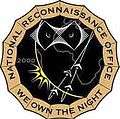 Patch commemorating launch of a classified payload
Patch commemorating launch of a classified payload
See also
References
- ↑ "NRO - Directors: Betty J. Sapp". www.nro.gov. Retrieved 25 October 2016.
- ↑ Intelligence Agencies Must Operate More Like An Enterprise
- ↑ "Contact the NRO" "National Reconnaissance Office Office of Public Affairs 14675 Lee Road Chantilly, VA 20151-1715"
- ↑ Federation of American Scientists. "The Evolving Role of the NRO".
- ↑ Official NRO Fact Sheet via http://www.nro.gov, accessed March 2012
- ↑ "Career Opportunities". Archived from the original on 2013-10-29. Retrieved 2013-07-08.
- ↑ Commission on the Roles and Capabilities of the United States Intelligence Community. "Preparing for the 21st Century: An Appraisal of U.S. Intelligence, Chapter 13 – The Cost of Intelligence".
- ↑ "National Reconnaissance Office (NRO) Center for the Study of National Reconnaissance (CSNR) Bulletin, Combined 2002 Issue" (PDF). Government Attic. Retrieved 26 October 2016.
- ↑ "NRO Provides Support to the Warfighters". Press Release. NRO Press Office. 28 April 1998. Archived from the original on 18 June 2001. Retrieved 26 October 2016.
- ↑ "U.S. Reconnaissance Satellites: Domestic Targets – Documents Describe Use of Satellites in Support of Civil Agencies and Longstanding Controversy". National Security Archive, The George Washington University. 2008-04-11. Retrieved 2008-04-12.
- ↑ "US satellites shadow China's submarines". Pakistan Defence. 13 May 2010. Retrieved 26 October 2016.
- ↑ Logo of New NRO Spy Satellite: An Octopus Engulfing the World with the Words "Nothing is Beyond Our Reach" Underneath
- 1 2 Stares, Paul B. "The Militarization of Space". p. 23,46. Archived from the original on 2009-01-13. Retrieved 2008-11-24.
- ↑ Jeffrey Richelson (1990). America's Secret Eyes in Space. Harper & Row.
- 1 2 3 Paglen, Trevor (February 2009). Blank Spots On the Map: The Dark Geography of the Pentagon's Secret World. New York: Dutton.
- 1 2 (Chief, Special Security Center) (1974-01-07). "History of NRO security breaches" (PDF). National Reconnaissance Office. Retrieved 2010-12-22.
- ↑ "CIA and others: secret agencies studied". Sarasota Herald-Tribune. Sarasota: Sarasota Herald-Tribune (published December 19, 1973): 4. 1973.
- 1 2 3 Bamford, James (1985). "America's Supersecret Eyes In Space". The New York Times. New York: The New York Times (published January 13, 1985).
- ↑ Jeffrey T. Richelson (September 18, 2008). "Out of the Black: The Declassification of the NRO". National Security Archive Electronic Briefing Book No. 257. National Security Archive. Retrieved 2008-10-13.
- ↑ Fitzgerald, Dennis D. (2005). "Risk Management and National Reconnaissance From the Cold War Up to the Global War on Terrorism" (PDF). Journal of Discipline and Practice, 2005-U1. NRO. Retrieved 2011-07-31.
- ↑ "Get Smarter: Demystifying the NRO". SECRECY & GOVERNMENT BULLETIN, Issue Number 39. Federation of American Scientists. August–September 1994. Retrieved 2008-10-13.
- ↑ "Lack of Intelligence". U.S. News & World Report. Archived from the original on 2012-10-23.
- ↑ Philip Taubman (2007-11-11). "Failure to Launch: In Death of Spy Satellite Program, Lofty Plans and Unrealistic Bids". The New York Times. Retrieved 2007-11-12.
- 1 2 3 John J. Lumpkin, Associated Press, "Agency planned exercise on September 11 built around a plane crashing into a building", Boston Chronicle, September 11, 2002.
- ↑ Coincidence of bomb exercises? – Channel 4 News
- ↑ John Schwartz (2008-02-05). "Satellite Spotters Glimpse Secrets, and Tell Them". The New York Times. Retrieved 2008-02-05.
- ↑ David Stout and Thom Shanker (2008-02-14). "U.S. Officials Say Broken Satellite Will Be Shot Down". The New York Times. Retrieved 2008-02-14.
- ↑ "DoD Succeeds In Intercepting Non-Functioning Satellite (release=No. 0139-08)" (Press release). U.S. Department of Defense. February 20, 2008. Retrieved 2008-02-20.
- ↑ Colin Clark (2008-07-03). "Spy Radar Satellites Declassified". DoD Buzz, through Military.com. Retrieved 2008-07-10.
- ↑ The Black Vault, "Download the declassified Satellite Reconnaissance: Secret Eyes in Space", NRO, August 2009.
- ↑ Bruce Carlson (April 14, 2010). "Bruce Carlson, Director, NRO, National Space Symposium, Remarks" (PDF). National Reconnaissance Office. Archived from the original (PDF) on May 27, 2010. Retrieved 2010-06-04.
- ↑ The IG complaint of Mark Phillips concerning the NRO | McClatchy. Mcclatchydc.com. Retrieved on 2013-07-21.
- ↑ Taylor, Marisa, "Sen. Charles Grassley Seeks Probe Of Polygraph Techniques At National Reconnaissance Office", The McClatchy Company, 27 July 2012
- ↑ Taylor, Marisa. (2014-04-22) WASHINGTON: IG: Feds didn't pass polygraph evidence of child abuse to investigators | Courts & Crime. McClatchy DC. Retrieved on 2014-04-28.
- ↑ NRO Organization. http://www.nrojr.gov/teamrecon/resource-template.html
- ↑ "NRO Factsheet". p. 1. Archived from the original (Word Document) on 2006-12-11. Retrieved 2007-01-15.
- 1 2 Bruce Carlson (2010-09-13). "National Reconnaissance Office Update" (PDF). Air & Space Conference and Technology Exposition 2010. Archived from the original (PDF) on 2010-12-06. Retrieved 2010-11-25.
- ↑ Tim Weiner (1994-08-09). "Ultra-Secret Office Gets First Budget Scrutiny". New York Times. Retrieved 2010-12-22.
- ↑ John Pike (2010). "FY2010 Intelligence Budget". www.globalsecurity.org. Retrieved 2010-12-22.
- ↑ Dilanian, Ken (2010-10-28). "Overall U.S. intelligence budget tops $80 billion". Los Angeles Times. Retrieved 2011-01-08.
- ↑ "America's Leadership Challenge". Archived from the original on August 4, 2002. Retrieved 2008-02-02. (pre-event publicity pamphlet for National Law Enforcement And Security Institute [NLSI] conference "Homeland Security: America's Leadership Challenge", September 6, 2002).
- ↑ Boyle, Rebecca (June 5, 2012). "NASA Adopts Two Spare Spy Telescopes, Each Maybe More Powerful than Hubble". Popular Science. Popular Science Technology Group. Retrieved June 5, 2012.
- ↑ "NRO Systems Overview - Module 2: Orbital Mechanics" (PDF). National Reconnaissance Office. 13 February 2012. Retrieved 2018-10-11.
- 1 2 3 4 5 6 7 Clapper, James R. (February 2012). "FY 2013 Congressional Budget Justification, Volume 1, National Intelligence Program Summary, Resource Exhibit No. 13" (PDF). DNI.
- ↑ Center for the Study of National Reconnaissance: Bulletin, Combined 2002 Issue: "Declassification of Early Satellite Reconnaissance Film"
- ↑ Dr. Bruce Berkowitz (September 2011). "The National Reconnaissance Office At 50 Years: A Brief History" (PDF). Center for the Study of National Reconnaissance. Retrieved 2011-10-24.
- ↑ "2009 National Intelligence / A Consumer's Guide" (PDF). Office of the Director of National Intelligence. 2009. Retrieved 2013-08-19. (page 74)
- ↑ Archived July 7, 2010, at the Wayback Machine.
- ↑ Mission Ground Station Declassification memo, 2008
- ↑ "NRO Mission Ground Station Declassification" (PDF). National Reconnaissance Office. 2008-10-15.
- ↑ Delta Green. Pagan Publishing. 1997. ISBN 1-887797-08-4.
External links
- NRO official website
- Space-Based Reconnaissance by MAJ Robert A. Guerriero
- National Security Archive: The NRO Declassified
- Memo of Declassification of NRO
- Additional NRO information from the Federation of American Scientists
- America's secret spy satellites are costing you billions, but they can't even get off the launch pad at the Wayback Machine (archived November 28, 2007) U.S. News & World Report, 8/11/03; By Douglas Pasternak
- Agency planned exercise on September 11 built around a plane crashing into a building, from Boston.com
- History of the US high-altitude SIGINT system
- History of the US reconnaissance system: imagery
Coordinates: 38°52′55″N 77°27′01″W / 38.88194°N 77.45028°W
